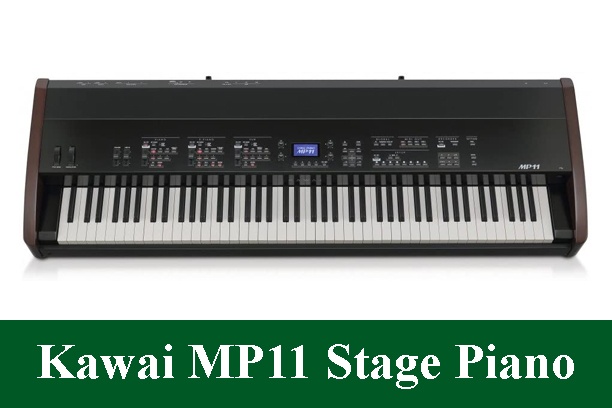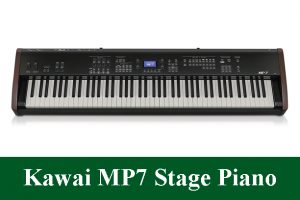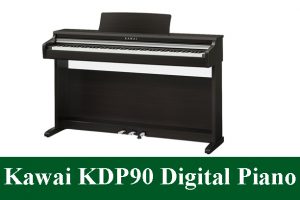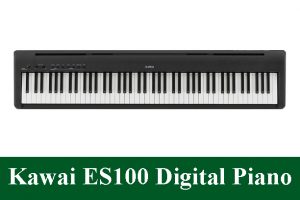Kawai MP11 Professional Stage Piano Review (Updated)
The Kawai MP11 offers 40 locally available sounds separated into three sorts: Piano, E. Piano, and Sub. Each compose has its own Volume slider on/off catch a Key Range catch that can be flipped between single, upper, and lower and a mode that permits an upper and lower key point of confinement to be set for every one of the three segments. Four classifications are accommodated each compose: Concert, Pop, Jazz, and Upright/Mono are found in the Acoustic area. Tine, Reed, Modern, and E. Fabulous/Clav possess the E. Piano segment. Strings, Pad, Harpsi/Mallet, and Bass take up the Sub(sidiary) area. The Piano and E. Piano classifications have three assortments, while every one of the Sub area classifications has four.
Every one of the three areas have devoted EFX and Reverb catches, however the E. Piano area additionally gives another list of impacts (EFX2) and amp choices. The impacts, and huge numbers of alternate elements of the Kawai MP11 , can each be flipped on and off by quickly squeezing the committed catches, and alter modes can be gotten to by squeezing and holding the equivalent.
A medium-sized 128 x 64-pixel LCD screen takes up the center, with two esteem handles on either side and four delicate keys specifically underneath it. A fifth catch under the screen flips between inner sounds and MIDI choices. To one side of the screen is the Edit segment, which gives cursor, yes/no, and alter/leave catches, and additionally two increasingly that let you store alters and bolt the controls to stay away from incidentally changing a sound while playing.
By the Edit segment, the Setup segment is utilized to choose programs that component mixes of the sounds, impacts, handle positions, fader levels, and other movable parameters; 26 banks of eight Setups can be chosen utilizing Bank L/R and 1-8 catches, and a committed catch turns the Setup area on and off. Over the Setup territory, Global controls enable access to EQ and transpose (contact to turn on and off, or hold to alter) and Local Off. Four catches beside those flip four MIDI control zones on and off, or permit altering of each zone.
The Recorder segment catches and plays back MIDI information up to 10 tunes (90,000 occasions) to the inside memory and stereo sound (MP3 or WAV) from the Kawai MP11 and its line contribution to a FAT or FAT32-good USB memory gadget. This segment includes a committed on/off catch, Metronome switch, and transport catches that permit Reset (bounce to the start of a sound document), Record, Rewind, Forward, and Play/Stop catches. A circle work is extremely helpful for learning and rehearsing secluded entries.
Features of Kawai MP11
One of the extraordinary parts of the Kawai MP11 is the Virtual Technician, which gives the player a chance to redo the control and voicing of the locally available sound set. This is a to a great degree ground-breaking and valuable arrangement of apparatuses that let the sound arrangement of the Kawai MP11 be dialed in to the essence of the individual entertainer, tending to even the most moment and unobtrusive points of interest.
Accessible parameters are:
- Voicing: Adjusts mallets, activity, and strings. (Ordinary, Mellow1, Mellow 2, Dynamic, Bright1 and Bright2)
- Stereo Width: Controls the stereo spread among lower and higher notes.
- String Resonance: Adjusts thoughtful vibration of any undampened strings in light of further notes being played.
- Damper Resonance: Adjusts vibration of all strings when notes are played with damper pedal down.
- Key-off Effect: Adjusts the sound of the damper contacting the strings to stop vibrations.
- Damper Noise: Adjusts the sound of the damper pedal being squeezed and discharged.
- Sledge Delay: Most capable of being heard when playing pianissimo.
- Fallback Noise: Alters the sound made after a key is discharged.
- Topboard: Adjusts cover position (Closed in addition to three degrees of receptiveness).
- Splendor: Adjusts the general brilliance of the instrument without influencing the voicing parameter.
Keyboard
The Kawai MP11 has outstanding amongst other inclination keyboards I’ve ever played in a non-acoustic instrument: strong, smooth, and to a great degree responsive. Kawai calls it Grand Feel, and I can comprehend why. The activity utilizes genuine wood all through the key, and highlights a reviewed activity (heavier in the bass) that turns here and there on a middle stick, driving a sledge up to the contact point from the back of each key. The keys are long, as well; the rotate length coordinates that of a genuine Kawai fabulous. Extra stabilizers in the lower keys convey a more practical feel, alongside a”let-off”mechanism that estimates the speed at which each key is discharged, all the more intently copying the vibe of an acoustic fantastic, particularly when the instrument is played delicately. Kawai’s triple-sensor framework joins a damper sensor notwithstanding the two that recognize keystroke quality, refining nuanced systems like rehashing a similar note. The key surfaces have an “Ivory Touch” matte complete that feels like my K. Kawai acoustic excellent. These contacts make the Kawai MP11 heavier than a few instruments, however it is justified, despite all the trouble in return for the extraordinary feel and execution. The main significant piece of the acoustic stupendous experience that is missing is the mechanical vibration that a genuine piano creates, which Yamaha’s AvantGrand pianos mimic successfully. Of course, those are far heavier and more costly instruments, with implicit speakers, implied for home and studio utilize.
Engineering
With up to 256 voices of polyphony, it’s relatively difficult to gag the Kawai MP11 , regardless of whether each of the three sound motors are locked in all the while. For the acoustic side of the instrument, each key of a Kawai EX Concert piano was inspected in stereo at numerous speeds, which were then spun together with Kawai’s Harmonic Imaging innovation. This has been overhauled in the Kawai MP11 to the XL (additional long) amendment, which dramatically increases the assets dedicated to the assault section of each note a basic time window regarding the human ear seeing authenticity. Devoted mono examples are additionally accommodated the individuals who shun stereo for live utilize. Seven unique tunings are close by (equivalent, unadulterated significant/minor, Pythagorean, mean tone, Werckmeister, and Kirnberger), and also two client quantifiable maps built by fine tunings of each key. Extend tuning can likewise be utilized.
For sound stone carvers who are on edge to burrow profound, recognizable synthesizer controls, for example, channel cutoff and reverberation and ADSR envelopes permit molding of the example set, which can likewise be swelled utilizing octave layering and detune parameters. As though that weren’t sufficient, vocal, chime, and air tests can be utilized to add another measurement to the instrument’s essential tones. Hell, even the metronome work goes well beyond: Not just would you be able to can choose from ten distinctive time marks, however you can likewise utilize any of 100 installed drum designs.
To the extent impacts preparing, the Kawai MP11 conveys in spades. Six spectacular sounding reverbs (Room, Lounge, three unique Halls, and Cathedral) that can be adjusted to taste are combined with an exhaustive determination of 129 impacts with up to ten editable parameters for each impact . . . what’s more, that is before getting to the five sorts of tweakable amp recreations, which serve up delectable flavors, for example, bag, guitar stack, combo amp, and the sky is the limit from there.
Toward the finish of the sound chain, a four-band EQ containing high and low racking with isolated completely parametric upper and lower midrange controls makes it simple to add the last touch to each finely made sound. Each reverb and EQ can likewise be balanced all inclusive, making it simple to make up for risky room sonics without tweaking the EQ and reverb for each program. Whoever thought of that unquestionably merits a raise.
Being used
The Kawai MP11 ‘s format is extraordinarily instinctive, with the most fundamental sound controls for the 40 locally available instruments on the left hand side of the control board, and the route, sound program determination, and recorder controls on the right. Area controls are basic and to the point, and join sensibilities, for example, not removing a managed note when every one is crippled continuously, so you can do things like kill a stacked string cushion under a piano program and still play the piano while pedal-holding the last activated string tones. Devoted volume sliders for each segment are likewise useful. It’s anything but difficult to utilize just the three arrangements of segment controls and not in any case waste time with multitimbral Setups.
Sonically, the Kawai MP11 is great. I put it through hell in my lounge alongside my KG-2C, in my studio through first class studio screens (with and without a sub), and at an “unplugged”- type blues stick at a companion’s place. The example set is immaculate through and through of the key range, at any powerful level and any issues that may emerge the extent that the recurrence substance can be tended to utilizing the channels and four-band EQ. The acoustic pianos are a delight to play; I lost all sense of direction in them for a considerable length of time. I give profound props for the majority of the varieties, yet the “Show” instrument was the one I continued returning to.
The electric pianos are apro either, conveying everything from unobtrusive smoothness to fat crunchiness. I built up a unique affection for the bag compose tine EPs, particularly once I began playing with the amp recreations. Additionally, it’s a delight to hear an alternate electric terrific sound from the one in most stage pianos; the one in the Kawai MP11 depends without anyone else EP308. [You may have seen Jeff Lorber underwriting it in 1980s-time issues of Keyboard. — Ed.]
Supporting sounds are warm and unpretentious, and include a beautiful sheen and nearness to the bread-and-spread console tones. Extra focuses ought to be granted for the locally available acoustic bass stacked with a ride cymbal; I cherish that sound in the left hand. It’s likewise fulfilling to turn on every one of the three motors without a moment’s delay and after that blend them utilizing each area’s committed volume slider. You can make some profound, imaginative custom sounds doing that, and afterward thump it out of the recreation center with the colossal choice of locally available impacts.
I think Kawai committed an error by not giving in excess of two catches to explore 26 conceivable banks. With such a gigantic measure of modifying potential outcomes, I needed to fabricate faster access banks for a few classifications. I can likewise observe a few clients being worried about the span of the presentation. Nonetheless, I don’t know that a greater or more beautiful screen would legitimize the extra expense or include much usefulness. To the extent the recorder segment, I didn’t invest much energy with it I’m more keen on the instrument itself yet all that I attempted worked precisely of course.
Pros
- Fabulous sound. Extraordinary compared to other inclination activities I’ve ever played on any electronic console.
- A huge amount of adaptability at pretty much every level.
Cons
- Significantly heavier than the normal stage piano.
- Bank choice is somewhat unbalanced just left/right bolt catches to get to 26 banks.
Primary concern
Killer console feel, exceptional sounds, thorough sound-chiseling instruments, and a huge amount of devoted controls make the Kawai MP11 a genuine contender for anybody searching for a top of the line proficient stage piano.
Conclusion
On the off chance that it isn’t as of now obvious, I’m totally charmed with the Kawai MP11. The sound set is extraordinary, it’s hugely simple to explore, and it’s a delight to play. It is certainly one of the best digital piano instruments I’ve had the chance to play.





